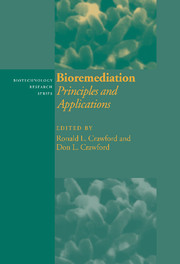Book contents
- Frontmatter
- Contents
- List of contributors
- Preface
- Introduction
- 1 Engineering of bioremediation processes: needs and limitations
- 2 Bioremediation in soil: influence of soil properties on organic contaminants and bacteria
- 3 Biodegradation of ‘BTEX’ hydrocarbons under anaerobic conditions
- 4 Bioremediation of petroleum contamination
- 5 Bioremediation of environments contaminated by polycyclic aromatic hydrocarbons
- 6 Bioremediation of nitroaromatic compounds
- 7 A history of PCB biodegradation
- 8 Bioremediation of chlorinated phenols
- 9 Biodegradation of chlorinated aliphatic compounds
- 10 Microbial remediation of metals
- 11 Molecular techniques in bioremediation
- Index
Preface
Published online by Cambridge University Press: 28 October 2009
- Frontmatter
- Contents
- List of contributors
- Preface
- Introduction
- 1 Engineering of bioremediation processes: needs and limitations
- 2 Bioremediation in soil: influence of soil properties on organic contaminants and bacteria
- 3 Biodegradation of ‘BTEX’ hydrocarbons under anaerobic conditions
- 4 Bioremediation of petroleum contamination
- 5 Bioremediation of environments contaminated by polycyclic aromatic hydrocarbons
- 6 Bioremediation of nitroaromatic compounds
- 7 A history of PCB biodegradation
- 8 Bioremediation of chlorinated phenols
- 9 Biodegradation of chlorinated aliphatic compounds
- 10 Microbial remediation of metals
- 11 Molecular techniques in bioremediation
- Index
Summary
Bioremediation is not a new concept in the field of applied microbiology. Microorganisms have been used to remove organic matter and toxic chemicals from domestic and manufacturing waste effluents for many years. What is new, over the past few decades, is the emergence and expansion of bioremediation as an industry, and its acceptance as an effective, economically viable alternative for cleaning soils, surface water, and groundwater contaminated with a wide range of toxic, often recalcitrant, chemicals. Bioremediation is becoming the technology of choice for the remediation of many contaminated environments, particularly sites contaminated with petroleum hydrocarbons.
Bioremediation has also become an intensive area for research and development in academia, government, and industry. Partly because of new laws requiring stricter protection of the environment and mandating the cleanup of contaminated sites, funding for both basic and applied research on bioremediation by government agencies, as well as by private industry, has increased dramatically over the past decade. As a result, rapid progress has been made in developing effective, economical microbial bioremediation processes. In an even broader sense, this increased activity has led to a surge of interest in ‘environmental microbiology’, a field covering a spectrum of disciplines, including microbial physiology and ecology, molecular genetics, organic chemistry, biochemistry, soil and water chemistry, geology, hydrology, and engineering. In the academic research environment, bioremediation has, in effect, become so scientifically broad and complex in both its basic and applied aspects that it has of necessity evolved into a multidisciplinary field that requires a ‘research center’ approach. At the University of Idaho, as just one example, we have built our multidisciplinary environmental remediation research program within the University of Idaho Center for Hazardous Waste Remediation Research.
Information
- Type
- Chapter
- Information
- BioremediationPrinciples and Applications, pp. xi - xiiPublisher: Cambridge University PressPrint publication year: 1996
Accessibility standard: Unknown
Why this information is here
This section outlines the accessibility features of this content - including support for screen readers, full keyboard navigation and high-contrast display options. This may not be relevant for you.Accessibility Information
- 1
- Cited by
